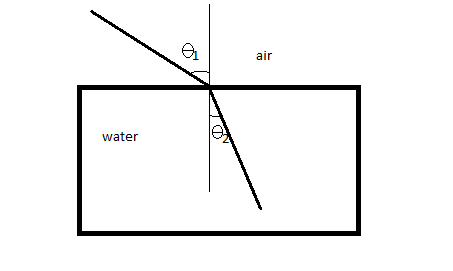
Define refraction and state laws of refraction.
Answer
476.1k+ views
Hint: when a light incident from one medium to the other changes its direction then this phenomenon is known as refraction of light. There are two laws of refraction that are used to describe the behavior of light after refraction.
Complete step by step answer:
A refraction is a phenomenon in which light changes its direction when it is subjected to one medium into the other. This change in the direction will be the cause of the difference in densities in two substances.
The figure below shows the refraction of light from air to water.

Here, you can see when a light travelling in the air is incident on the water it changes its angle from
LAWS OF REFRACTION:
There are two laws of refraction which are given below:
The first law of refraction: the first law of refraction states that the incident ray, the refracted ray, and the normal, to the interface of the two mediums at the incidence point, lie in the same plane.
The second law of refraction: the second law of refraction states that the ratio of the sine of the angle of incidence and the sine of the angle of refraction is constant. This law is also known as Snell’s law and is given by
Here,
Note:
If the light enters a medium having a high refractive index, it will slow down and it will bend towards the normal.
If the light enters a medium having a low refractive index, it will speed up and it will bend away from the normal.
The second law of refraction states that the ratio of the sine of the angle of incidence and the sine of the angle of refraction is constant.
Complete step by step answer:
A refraction is a phenomenon in which light changes its direction when it is subjected to one medium into the other. This change in the direction will be the cause of the difference in densities in two substances.
The figure below shows the refraction of light from air to water.

Here, you can see when a light travelling in the air is incident on the water it changes its angle from
LAWS OF REFRACTION:
There are two laws of refraction which are given below:
The first law of refraction: the first law of refraction states that the incident ray, the refracted ray, and the normal, to the interface of the two mediums at the incidence point, lie in the same plane.
The second law of refraction: the second law of refraction states that the ratio of the sine of the angle of incidence and the sine of the angle of refraction is constant. This law is also known as Snell’s law and is given by
Here,
Note:
If the light enters a medium having a high refractive index, it will slow down and it will bend towards the normal.
If the light enters a medium having a low refractive index, it will speed up and it will bend away from the normal.
The second law of refraction states that the ratio of the sine of the angle of incidence and the sine of the angle of refraction is constant.
Recently Updated Pages
Express the following as a fraction and simplify a class 7 maths CBSE

The length and width of a rectangle are in ratio of class 7 maths CBSE

The ratio of the income to the expenditure of a family class 7 maths CBSE

How do you write 025 million in scientific notatio class 7 maths CBSE

How do you convert 295 meters per second to kilometers class 7 maths CBSE

Write the following in Roman numerals 25819 class 7 maths CBSE

Trending doubts
Give 10 examples of unisexual and bisexual flowers

Draw a labelled sketch of the human eye class 12 physics CBSE

Differentiate between homogeneous and heterogeneous class 12 chemistry CBSE

Differentiate between insitu conservation and exsitu class 12 biology CBSE

What are the major means of transport Explain each class 12 social science CBSE

Franz thinks Will they make them sing in German even class 12 english CBSE




